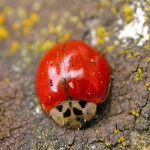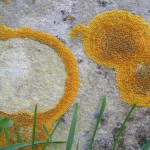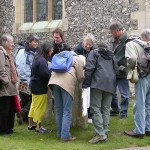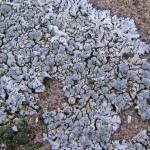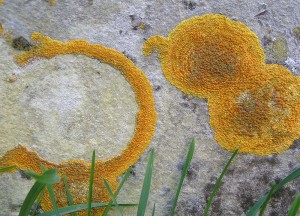
Members gathered in the churchyard of St Peter and St Paul, Shiplake, Oxfordshire on Saturday 17th October 2009 to look at lichens. Leader James Wearn began the afternoon by explaining the reasons for choosing the site. It had been more than thirty years since a lichen walk had been led in the churchyard, the last being directed by the renowned botanist Francis Rose during the late 1970s. In addition, there is a good diversity of lichens in such a small area, which is ideal for enthusing beginners and more knowledgeable members alike.
James explained that different species could be found on acidic and basic stone (largely affected by pH levels) and demonstrated the range of forms from shrubby (fruticose) or leaf-like (foliose) to crust-forming (crustose). The colours of lichens in the churchyard range from white, bright yellow, and orange to shades of green, blue-green, grey and black. Using a hand lens the group examined the different reproductive structures and their importance as indicators of different lichen families or species. The group also discussed the ecology of lichens and James received some excellent questions regarding the effects of the environment, including light levels and precipitation. The group then walked along the track next to the Thames to look at lichens on trees.
A list of non-lichen species encountered is included below. A full lichen species list will be included as a separate article by James in the 2009 volume of our journal, The Reading Naturalist (to be distributed in March 2010).
§ Grey Cushion-moss, Grimmia pulvinata – on the tops of many of the basic headstones.
§ Wall Rue, Asplenium ruta-muraria – church wall.
§ Pellitory-of-the-Wall, Parietaria judaica – church wall.
§ Woody Nightshade, Solanum dulcamara – south side of church by the wall.
§ Dark Mullein, Verbascum nigrum – south side of church by the wall.
§ Harlequin Ladybird, Harmonia axyridis – unspotted orange form on top of headstone.
§ Ruby Tiger Moth caterpillar, Phragmatobia fuliginosa – walking along the track outside the boatyard.
(article and lichen photos by James Wearn, other photos by Jan Haseler.)

